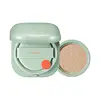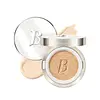What's inside
What's inside
 Key Ingredients
Key Ingredients

 Benefits
Benefits

 Concerns
Concerns

 Ingredients Side-by-side
Ingredients Side-by-side

Water
Skin ConditioningCI 77891
Cosmetic ColorantCyclopentasiloxane
EmollientMethyl Trimethicone
Skin ConditioningEthylhexyl Methoxycinnamate
UV AbsorberCaprylyl Methicone
Skin ConditioningPEG-10 Dimethicone
Skin ConditioningPropanediol
SolventCyclohexasiloxane
EmollientPolymethyl Methacrylate
CI 77492
Cosmetic ColorantZinc Oxide
Cosmetic ColorantTrimethylsiloxysilicate
EmollientTitanium Dioxide
Cosmetic ColorantNylon-12
Lauryl PEG-9 Polydimethylsiloxyethyl Dimethicone
Skin ConditioningHdi/Trimethylol Hexyllactone Crosspolymer
Disteardimonium Hectorite
StabilisingCI 77491
Cosmetic Colorant1,2-Hexanediol
Skin ConditioningAluminum Hydroxide
EmollientSodium Chloride
MaskingAcrylates/Dimethicone Copolymer
Skin ConditioningIsopropyl Titanium Triisostearate
EmollientAcrylates/Ethylhexyl Acrylate/Dimethicone Methacrylate Copolymer
Skin ConditioningParfum
MaskingCaprylyl Glycol
EmollientBis-PEG-15 Dimethicone/Ipdi Copolymer
Stearic Acid
CleansingPEG-2 Soyamine
EmulsifyingEthylhexylglycerin
Skin ConditioningCI 77499
Cosmetic ColorantDisodium EDTA
Triethoxycaprylylsilane
Silica
AbrasiveCitronellol
PerfumingGeraniol
PerfumingLimonene
PerfumingBHT
AntioxidantHydroxycitronellal
PerfumingTocopherol
AntioxidantWater, CI 77891, Cyclopentasiloxane, Methyl Trimethicone, Ethylhexyl Methoxycinnamate, Caprylyl Methicone, PEG-10 Dimethicone, Propanediol, Cyclohexasiloxane, Polymethyl Methacrylate, CI 77492, Zinc Oxide, Trimethylsiloxysilicate, Titanium Dioxide, Nylon-12, Lauryl PEG-9 Polydimethylsiloxyethyl Dimethicone, Hdi/Trimethylol Hexyllactone Crosspolymer, Disteardimonium Hectorite, CI 77491, 1,2-Hexanediol, Aluminum Hydroxide, Sodium Chloride, Acrylates/Dimethicone Copolymer, Isopropyl Titanium Triisostearate, Acrylates/Ethylhexyl Acrylate/Dimethicone Methacrylate Copolymer, Parfum, Caprylyl Glycol, Bis-PEG-15 Dimethicone/Ipdi Copolymer, Stearic Acid, PEG-2 Soyamine, Ethylhexylglycerin, CI 77499, Disodium EDTA, Triethoxycaprylylsilane, Silica, Citronellol, Geraniol, Limonene, BHT, Hydroxycitronellal, Tocopherol
Water
Skin ConditioningCyclopentasiloxane
EmollientCI 77891
Cosmetic ColorantDimethicone
EmollientTrimethylsiloxysilicate
EmollientGlycerin
HumectantIsododecane
EmollientNiacinamide
SmoothingPEG-10 Dimethicone
Skin Conditioning1,2-Hexanediol
Skin ConditioningDimethicone Crosspolymer
Emulsion StabilisingPEG/PPG-18/18 Dimethicone
EmulsifyingTuber Magnatum Extract
Skin ConditioningJasminum Officinale Flower Extract
MaskingNelumbium Speciosum Flower Extract
Skin ConditioningFreesia Refracta Extract
Skin ConditioningIris Versicolor Extract
EmollientLoess Extract
Skin ConditioningLilium Candidum Bulb Extract
Skin ConditioningNarcissus Pseudonarcissus Flower Extract
Skin ConditioningRosa Damascena Flower Extract
MaskingMagnesium Sulfate
Polyglyceryl-3 Polydimethylsiloxyethyl Dimethicone
Skin ConditioningOctyldodecanol
EmollientSynthetic Fluorphlogopite
Aluminum Hydroxide
EmollientStearic Acid
CleansingTriethoxycaprylylsilane
Alumina
AbrasivePolyhydroxystearic Acid
EmulsifyingDimethicone/Vinyl Dimethicone Crosspolymer
Skin ConditioningPolyglyceryl-4 Isostearate
EmulsifyingDisteardimonium Hectorite
StabilisingAdenosine
Skin ConditioningIsopropyl Titanium Triisostearate
EmollientTrisodium Ethylenediamine Disuccinate
Neopentyl Glycol Diethylhexanoate
EmollientPolyglyceryl-10 Laurate
Skin ConditioningButylene Glycol
HumectantGlutathione
Ethylhexylglycerin
Skin ConditioningArginine
MaskingCarbomer
Emulsion StabilisingParfum
MaskingCI 77492
Cosmetic ColorantCI 77491
Cosmetic ColorantCI 77499
Cosmetic ColorantWater, Cyclopentasiloxane, CI 77891, Dimethicone, Trimethylsiloxysilicate, Glycerin, Isododecane, Niacinamide, PEG-10 Dimethicone, 1,2-Hexanediol, Dimethicone Crosspolymer, PEG/PPG-18/18 Dimethicone, Tuber Magnatum Extract, Jasminum Officinale Flower Extract, Nelumbium Speciosum Flower Extract, Freesia Refracta Extract, Iris Versicolor Extract, Loess Extract, Lilium Candidum Bulb Extract, Narcissus Pseudonarcissus Flower Extract, Rosa Damascena Flower Extract, Magnesium Sulfate, Polyglyceryl-3 Polydimethylsiloxyethyl Dimethicone, Octyldodecanol, Synthetic Fluorphlogopite, Aluminum Hydroxide, Stearic Acid, Triethoxycaprylylsilane, Alumina, Polyhydroxystearic Acid, Dimethicone/Vinyl Dimethicone Crosspolymer, Polyglyceryl-4 Isostearate, Disteardimonium Hectorite, Adenosine, Isopropyl Titanium Triisostearate, Trisodium Ethylenediamine Disuccinate, Neopentyl Glycol Diethylhexanoate, Polyglyceryl-10 Laurate, Butylene Glycol, Glutathione, Ethylhexylglycerin, Arginine, Carbomer, Parfum, CI 77492, CI 77491, CI 77499
 Reviews
Reviews

Ingredients Explained
These ingredients are found in both products.
Ingredients higher up in an ingredient list are typically present in a larger amount.
1,2-Hexanediol is a synthetic liquid and another multi-functional powerhouse.
It is a:
- Humectant, drawing moisture into the skin
- Emollient, helping to soften skin
- Solvent, dispersing and stabilizing formulas
- Preservative booster, enhancing the antimicrobial activity of other preservatives
Aluminum Hydroxide is a form of aluminum. It can be naturally found in nature as the mineral gibbsite. In cosmetics, Aluminum Hydroxide is used as a colorant, pH adjuster, and absorbent.
As a colorant, Aluminum Hydroxide may add opacity, or reduce the transparency. Aluminum hydroxide is contains both basic and acidic properties.
According to manufacturers, this ingredient is an emollient and humectant. This means it helps hydrate the skin.
In medicine, this ingredient is used to help relieve heartburn and help heal ulcers.
There is currently no credible scientific evidence linking aluminum hydroxide in cosmetics to increased cancer risk.
Major health organizations allow the use of aluminum hydroxide in personal care products and have not flagged it as a carcinogenic risk at typical usage levels.
Learn more about Aluminum HydroxideCi 77491 is also hydrated iron III oxide. It's sole purpose is to give a red/pink hue to products.
Iron III oxides are classified as inorganic chemicals for coloring.
Synthetically created Ci 77491 is considered safer than those naturally found. This is because the synthetically created version may contain less impurities. Iron oxides are generally non-toxic and non-allergenic.
Learn more about CI 77491Ci 77492 is also hydrated iron III oxide. It's sole purpose is to give a yellow hue to products.
Iron III oxides are classified as inorganic chemicals for coloring.
Synthetically created Ci 77492 is considered safer than those naturally found. This is because the synthetically created version may contain less impurities. Iron oxides are generally non-toxic and non-allergenic.
Learn more about CI 77492Ci 77499 is also hydrated iron III oxide. It is created from mixing red and black iron oxides. This helps give shades of darkness to a product.
Iron III oxides are classified as inorganic chemicals for coloring.
Ci 77891 is a white pigment from Titanium dioxide. It is naturally found in minerals such as rutile and ilmenite.
It's main function is to add a white color to cosmetics. It can also be mixed with other colors to create different shades.
Ci 77891 is commonly found in sunscreens due to its ability to block UV rays.
Learn more about CI 77891Cyclopentasiloxane, or D5, is a silicone used to improve texture of products and trap moisture.
D5 is considered lightweight and volatile. Volatile means it evaporates quickly after application. Once evaporated, D5 leaves a thin barrier that helps keep skin hydrated.
It is also an emollient. Emollients help soften the skin and prevent water loss. Silicones create a silky texture in products. D5 helps other ingredients become more spreadable.
Studies show D5 is safe to use in skincare products. We recommend speaking with a skincare professional if you have concerns.
Learn more about CyclopentasiloxaneDisteardimonium Hectorite comes from the clay mineral named hectorite. It is used to add thickness to a product.
It can also help stabilize a product by helping to disperse other ingredients.
Hectorite is a rare, white clay mineral.
Learn more about Disteardimonium HectoriteEthylhexylglycerin (we can't pronounce this either) is commonly used as a preservative and skin softener. It is derived from glyceryl.
You might see Ethylhexylglycerin often paired with other preservatives such as phenoxyethanol. Ethylhexylglycerin has been found to increase the effectiveness of these other preservatives.
Isopropyl Titanium Triisostearate isn't fungal acne safe.
Parfum is a catch-all term for an ingredient or more that is used to give a scent to products.
Also called "fragrance", this ingredient can be a blend of hundreds of chemicals or plant oils. This means every product with "fragrance" or "parfum" in the ingredients list is a different mixture.
For instance, Habanolide is a proprietary trade name for a specific aroma chemical. When used as a fragrance ingredient in cosmetics, most aroma chemicals fall under the broad labeling category of “FRAGRANCE” or “PARFUM” according to EU and US regulations.
The term 'parfum' or 'fragrance' is not regulated in many countries. In many cases, it is up to the brand to define this term.
For instance, many brands choose to label themselves as "fragrance-free" because they are not using synthetic fragrances. However, their products may still contain ingredients such as essential oils that are considered a fragrance by INCI standards.
One example is Calendula flower extract. Calendula is an essential oil that still imparts a scent or 'fragrance'.
Depending on the blend, the ingredients in the mixture can cause allergies and sensitivities on the skin. Some ingredients that are known EU allergens include linalool and citronellol.
Parfum can also be used to mask or cover an unpleasant scent.
The bottom line is: not all fragrances/parfum/ingredients are created equally. If you are worried about fragrances, we recommend taking a closer look at an ingredient. And of course, we always recommend speaking with a professional.
Learn more about ParfumPeg-10 Dimethicone is silicone with conditioner and emulsifier properties. It mostly acts as an emollient in skincare and and humectant in haircare.
According to the manufacturer, acidic formulations decrease the stability of this ingredient. It works best in neutral or near neutral formulations.
Stearic Acid is a fatty acid. It is an emollient, emulsifier, and texture enhancer.
As an emollient, stearic acid helps soften skin. It aids the skin's protective barrier by preventing water loss. It also provides a gentle cleansing effect without stripping away natural oils.
Stearic acid may also be used to enhance the texture of products. It can add volume and stabilize ingredients such as water and oil. This can help water and oil ingredients from separating.
Sources of stearic acid include animal or vegetable fats/oils such as coconut or shea. It can be naturally found in butter, cocoa butter, shea butter, vegetable fats, and animal tallow.
This ingredient may not be Malassezia folliculitis, or fungal-acne safe.
Learn more about Stearic AcidTriethoxycaprylylsilane is a silicone used to bind and stabilize ingredients.
As an emulsifier, it helps prevent ingredients from separating. This can help elongate the shelf life of products.
Triethoxycaprylylsilane is often used to coat mineral sunscreens ingredients to help give a better feel. It also helps reduce oxidative stress in sunscreens.
Learn more about TriethoxycaprylylsilaneThis silicone is an emollient. Emollients create a thin film on the skin to prevent moisture from escaping.
It is not soluble in water and helps increase water-resistance in products.
According to a manufacturer, it can blend seamlessly with silicone oils, such as Cyclopentasiloxane.
Learn more about TrimethylsiloxysilicateWater. It's the most common cosmetic ingredient of all. You'll usually see it at the top of ingredient lists, meaning that it makes up the largest part of the product.
So why is it so popular? Water most often acts as a solvent - this means that it helps dissolve other ingredients into the formulation.
You'll also recognize water as that liquid we all need to stay alive. If you see this, drink a glass of water. Stay hydrated!
Learn more about Water